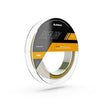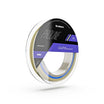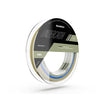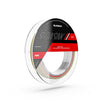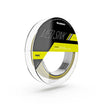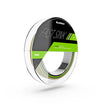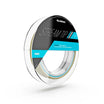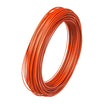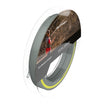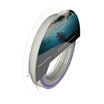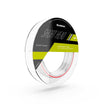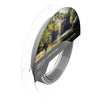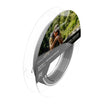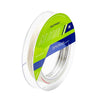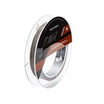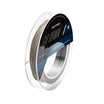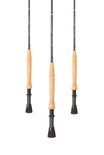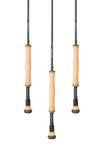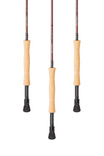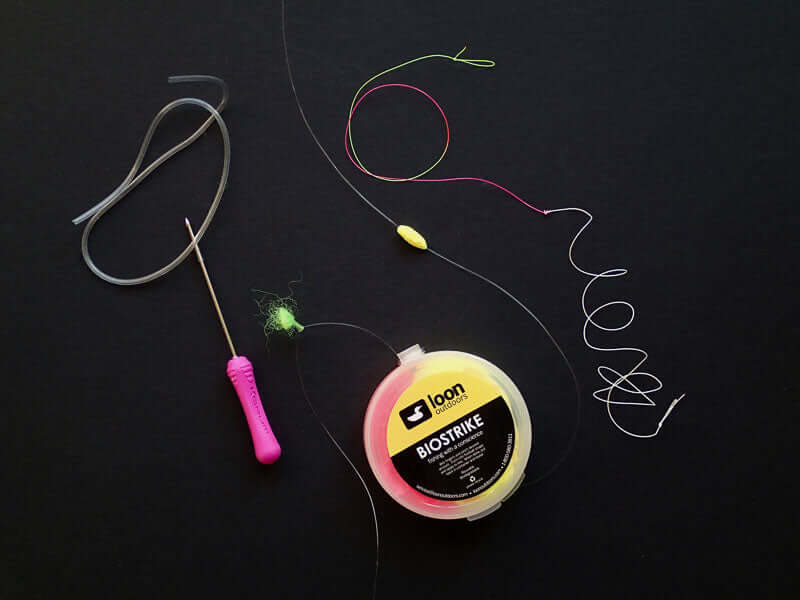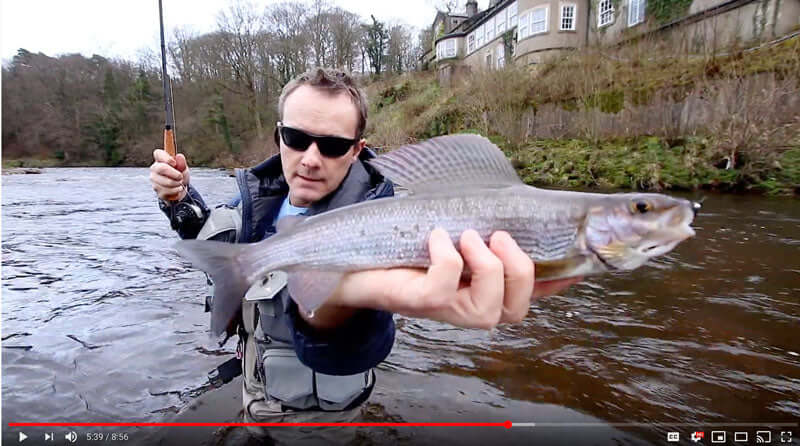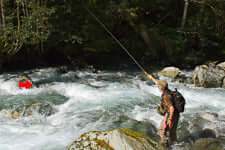Article by Dave Southall
My favourite form of subsurface fly fishing is ‘sight fishing’ with nymphs, grayling bugs & shrimp patterns on chalk streams & other gin-clear rivers where I can target visible fish & watch them take my fly. However there are many situations when due to poor light conditions, poor water clarity or a dark riverbed the fish & fly can’t be seen. On such occasions it is sometimes possible to see the take as a fish flashes its flank or if using a highly visible fly such as a bead-head nymph with a white bead the fly can be seen to ‘disappear’ as a fish takes it. Also there are times when a take can be felt, particularly if swinging spiders downstream, a method that I never use. Generally in such situations the angler needs some type of ‘indicator’ on the line/leader to show when a fish has taken the fly.
When I first started fly fishing in the late 1960s, fishing mainly on the Yorkshire River Rye, my favourite subsurface flies were, a Partridge & Orange spider, a Snipe & Purple spider, Sawyer’s Pheasant Tail nymph & pink or orange Leaded Shrimps. I used two methods to indicate a take to my flies that were invariably fished upstream. On smooth water I used a well-greased leader, watching the floating part for any change in sink-rate or any slight halt in its downstream progress. On more broken water I fished a dry Greenwell’s Glory on a top dropper as a fish-catcher & indicator (at that time I usually fished 3 flies). In the early 1970s, having moved down to Hertfordshire to work, I fished on a small still water stocked with brown & rainbow trout & there I generally fished a single Buzzer Pupa as a point fly suspended from a big, buoyant, dry fly on a short dropper, using the dry fly to hold my buzzer at a suitable depth & to act as an indicator.

- A young author with a Yorkshire Rye grayling caught on a Sawyer PT nymph using a greased leader to indicate takes.
So what methods of indication do I use now, over 50 years later?
I still use a Greased Leader (treated with Lineslik) when fishing light subsurface flies on smooth sections of rivers & on small still waters when fishing at close range. It is a very sensitive & unobtrusive method that is unlikely to scare the fish & since it creates virtually no resistance to a taking fish it is unlikely to cause a premature ejection of a fly that has been inhaled (Don Stazicker’s amazing underwater videos show that a fish can reject a fly that they sense is suspicious within 0.2 seconds of having inhaled it). A modern improvement on this method is to apply Fluorescent Neon Wax to a section of the leader butt, making it even more visible.
I also still use wet flies suspended under a dry fly, what we nowadays call the Duo/Trio or Klink & Dink. I prefer to attach the dropper with the nymph from the eye of my dry fly hook since I always use barbless hooks & tying off from the hook bend (New Zealand Style) can result in the dropper coming off & also sometimes results in missed takes to the dry fly, particularly with grayling as the line coming off the hook bend can stop the fish inhaling the fly. Fishing the dry fly on a short dropper reduces the number of missed takes to the dry fly but makes the rig a bit less sensitive to takes to the nymph. Big, buoyant flies like Elk Hair Caddis, Foam-bodied Beetles & Mayflies will support quite heavy flies. When fishing a spider just subsurface I like to use the Washing Line setup with my dry fly on the point & the spider on a short dropper & with only the dropper ungreased. The dry fly not only ensures that the spider stays close to the surface but also acts as an indicator of not only a take but also of when drag sets in to the system.
My most used method is a Greased Tri-coloured Semi-curly Monofilament Indicator. This I attach ‘loop to loop’ to the end of a 7’ tapered section (tapering from 0.43mm to 0.20mm diameter) attached to my fly line (usually a Sunray Jeremy Lucas 0 weight or 1 weight line & sometimes, if I’m purely nymph fishing rather than mixing it with dry fly, a Sunray Micro Nymph line). I prefer to use this method at quite close range with a long rod (Sunray Volition 10’ 2 weight JL, Sunray 10’6” Zero or Sunray Microlite 10’ 4 weight), casting up & across the stream then holding the indicator just above the water surface whilst tracking the rod downstream, keeping the line, leader & tippet just in tension. Takes vary from the slightest hesitation in the downstream progress of the indicator or a straightening of the curls in the indicator to in rare cases the indicator shooting up or across the flow. If fishing at longer range or when using this method on still waters with flies that are light enough to be supported by the greased indicator I watch the floating indicator for any unusual movement. The coils stand up above the water surface aiding visibility & clearly straightening when a fish takes the fly. Like a greased leader, with this method a taking fish feels virtually no resistance so is less likely to reject a fly that it has just taken. To make the mono curl I pull the indicator between my thumb nail & forefinger.

- Grayling caught with a 10’ 4 weight rod, 1 weight line, 7’ tapered leader, 15” Semi-curly Tri-coloured Indicator & 5’ of tippet with 2 flies (indicator held above the water).
If I need an indicator that will support a heavier fly my favourite method when I just want to fish one fly is the New Zealand Wool/Yarn Indicator. This type of indicator is very buoyant when treated with floatant such as Gink or Lineslik & it is highly visible. A big advantage is the ability to move the indicator easily along the leader to vary the depth at which the fly or flies fish. It does, however, generate a bit of drag/resistance when a fish takes & the indicator is sometimes taken by the fish. It is also fairly air-resistant & so can reduce casting distance. A needle with an open-ended eye at the tip is needed so that a short piece of silicone tubing can be slipped over a loop of leader/tippet into which a piece of wool/yarn can be inserted, then pulled down into the silicone tubing to lock the indicator in place.
If I’m dry fly fishing & I want to briefly change to nymph fishing I sometimes use Buoyant Fluorescent Putty (Loon Biostrike) squeezed onto the thick butt of my tapered leader or onto the knot joining my tapered leader to the level tippet. The disadvantages are it lands splashily, some resistance is quite likely to be felt by a taking fish & it is often taken by a fish, which can be very frustrating. The advantages are simplicity of use, the ability to support reasonably heavy flies if a big piece of putty is used & it can easily be repositioned to alter the depth at which the fly or flies fish.

- New Zealand Wool Indicator (left), Buoyant Putty (center), 15” Semi-curly Tri-coloured Indicator (right)
I hate the big, super buoyant Bungs made of polystyrene, cork or hollow plastic. They are generally clumsy, big, create a lot of resistance to a taking fish & are either difficult to adjust the depth or if designed to be easily moved along the line some tend to easily fall off during casting. In my opinion indicators should be visible, only just buoyant enough to support the flies that are being used, easy to cast, easy to attach & move on the line & unobtrusive so that they do not scare the fish.
Some folks frown on the use of indicators, considering them to be ‘float-fishing’ & thus unsporting, but for those with poor sight they are a Godsend & as for those folks who consider that a Buzzer Pupa suspended under a ‘Bung’ to be unsporting yet are happy to swing a team of Buzzers with the wind or retrieve their Buzzers with a figure of eight retrieve, well they obviously have no idea how slowly real Buzzer Pupae move. Love them or loathe them indicators are here to stay. I love some & loathe others!



